Google Unveils SynthID Text for Watermarking AI-Generated Content 🎉🤖
In an exciting development for the tech world, Google has unveiled SynthID Text, a groundbreaking technology designed to watermark and identify text generated by AI systems. As the demand for transparency in digital content grows, this release couldn't come at a more crucial time! 🌍✨
What is SynthID Text? 🧐
SynthID Text is Google’s new tool that allows developers to watermark AI-generated text, making it easier to detect its origins. This technology is set to revolutionize content authenticity in an AI-driven world. Developers can easily access SynthID Text through Hugging Face or Google’s Responsible GenAI Toolkit. As Google stated, "We’re open-sourcing our SynthID Text watermarking tool," providing free access to developers and businesses looking to distinguish their AI content. 📜🔍
How Does It Work? ⚙️
So, how exactly does SynthID Text achieve this remarkable feat? The technology works by modulating the likelihood of certain "tokens" being generated by AI models. Each token can be a character or word, forming the basic units of text created by AI. By adjusting the probabilities associated with these tokens, SynthID adds a layer of information that acts as a watermark, helping to determine if text was AI-generated. According to Google, the system doesn’t compromise the quality, speed, or accuracy of the generated text. 🚀💬
Caveats to Consider 🚧
While SynthID Text is a significant leap forward, Google acknowledges some limitations. The tool may struggle with short text, rewritten content, or when answering factual questions where accuracy is paramount. As stated, "On responses to factual prompts, there are fewer opportunities to adjust the token distribution without affecting the factual accuracy." 📉🔍
The Bigger Picture 🌐
Google isn't alone in this endeavor; other companies like OpenAI are also researching watermarking techniques to combat the rise of misleading AI-generated content. As we venture deeper into the AI era, watermarking could play a pivotal role in preserving content integrity and combating misinformation. 🌍❗
With governmental bodies like California and China initiating mandatory watermarking regulations for AI-generated content, we are at a turning point. The European Union’s prediction that 90% of online content could be synthetically generated by 2026 exacerbates this urgency, calling for robust systems to verify authenticity. 📜🚨
Conclusion 🎊
With the launch of SynthID Text, Google has taken a noteworthy step toward ensuring accountability in AI-generated content. As developers and businesses start utilizing this tool, it raises an essential question: How will this technology shape the future of content creation and consumption?
Stay tuned for more updates, and don’t forget to subscribe to TechCrunch's AI newsletter for the latest in AI developments! 📰🤖
What are your thoughts on SynthID Text? Will it effectively tackle the challenges of AI-generated content? Share your opinions in the comments below!

More Stories
Meta’s AR Ambitions and AI Safety: Insights from the Equity Podcast
Insight Partners Data Breach: A Wake-Up Call for Cybersecurity Awareness
Lovable’s Ascendancy: Anton Osika at TechCrunch Disrupt 2025